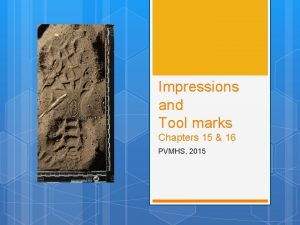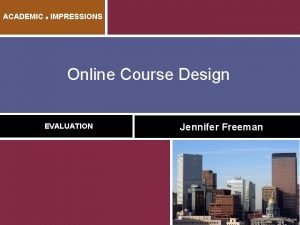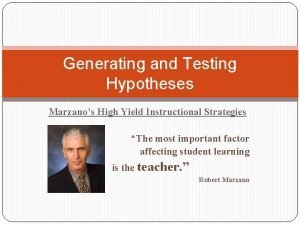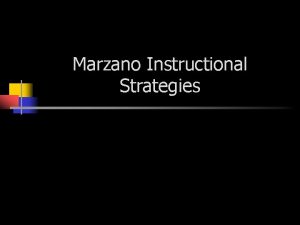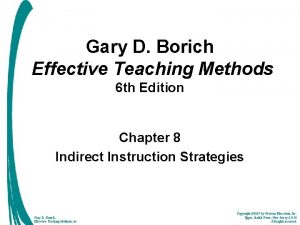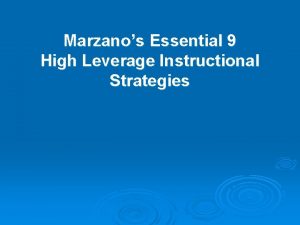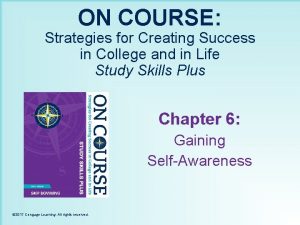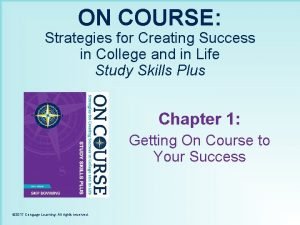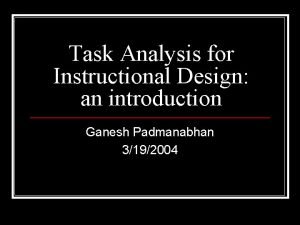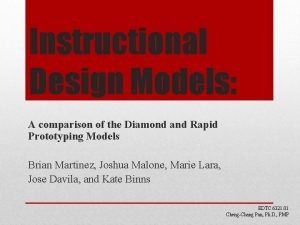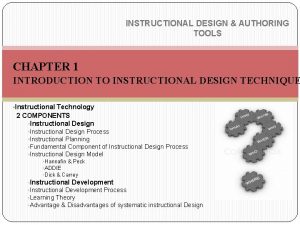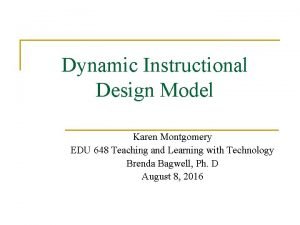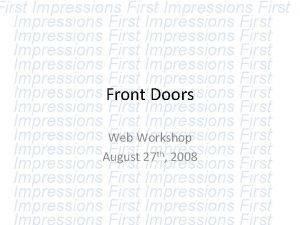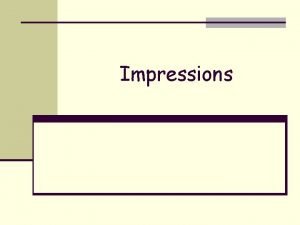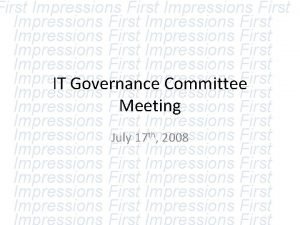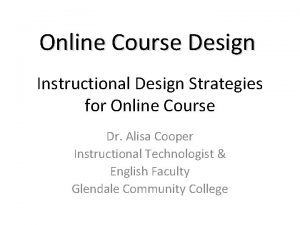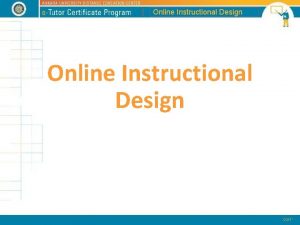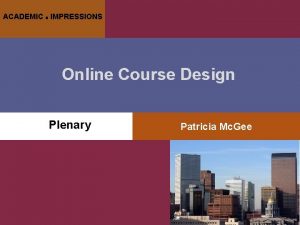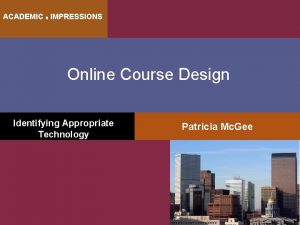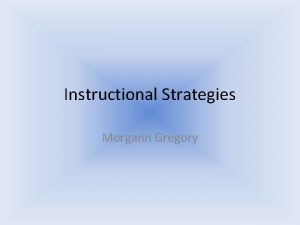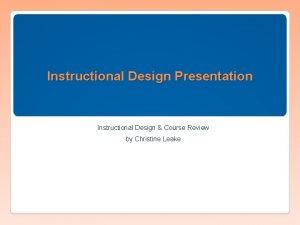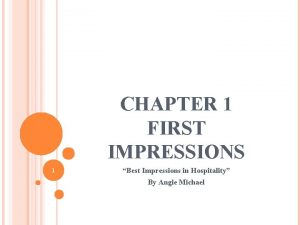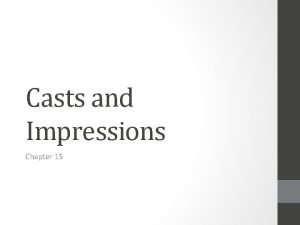ACADEMIC IMPRESSIONS Online Course Design Instructional Design Strategies




















- Slides: 20

ACADEMIC ■ IMPRESSIONS Online Course Design Instructional Design Strategies for Online Courses Alisa Cooper Ed. D Veronica Diaz, Ph. D

Presenters Alisa Cooper, Ed. D Veronica Diaz, Ph. D Instructional Technology Manager, Maricopa Center for Learning and Instruction, Maricopa Community Colleges Adjunct Faculty, NAU English Faculty South Mountain Community College Maricopa Center for Learning and Instruction Technology Faculty Developer

Converting or Creating? Face to Face • Pros and cons • Pitfalls and opportunities Hybrid Online New Online

Starting with Objectives • • Bloom’s Taxonomy Assessment Depth of learning First step in creating modules

Bloom’s Taxonomy • Focus on learner performance/outcomes • For each module – What do they need to know? – What do they need to be able to do? – What will they know as a result of my instruction? – What can they learn in other ways? create evaluate analyze apply understand remember http: //online-course-design. pbwiki. com/Instructional-Design. Strategies-for-Online-Courses

Why Modules? • “ 7 +/-2 rule” • Support consistency in look and feel • Easier to find course content • Content becomes/feels more manageable • Prevents information overload • Allows students to focus on content rather than form Source: Blending In, March 2007

Module Possibilities • Content “chunks” • Let the content set the chunks • Content organized in conceptually related blocks • Apply past experience Readings Video Assessment Project Writing Source: Blending In, March 2007

Course Organization • • • Dates Topic Readings Section Unit Module

3 Basic Redesign Steps 1. Identify course content for each module 2. Write learning objectives for each module 3. Consider each learning objective or each learning objective set and reference and utilize diverse instructional strategy possibilities

Lectures Assessment s Readings Activities Cases Face 2 Face Online Research Multimedia Demonstrations Writing Discussions Projects

5 Principles of Successful Course Redesign • Redesign the whole course. • Encourage active learning. • Provide students with individualized assistance. • Build in ongoing assessment and prompt feedback. • Ensure sufficient time on task and monitor student progress. http: //thencat. org/Plan. Res/R 2 R_Prin. CR. htm

Assessment & Evaluation Assessment - characterizes the value and appraisal of the individual; well institutionalized, if not always accurate about learner achievement. Evaluation – makes a judgment about the value of instructional experiences and designs; less documented across programs colleges, institutions.

Continuum of Assessment

Assessment Learning Principles • Determine appropriate type of assessment for what is being learned. • Encourage not only content achievement but assessment of perceived progress and attitude. • Track factors that may impede achievement • Incorporate meta-cognitive assessments.

Assessment Learning Principles • Include objectives with activities/assignments. • When appropriate, use rubrics. • Include learners in performance/ assessment measures. • Provide a strategy for self-assessment and progress.

Your Online Course Toolbox • Worksheets – Using Bloom’s Taxonomy for Objective Development – Mapping Your Course • Resources – Course re(Design) Resources wiki page – Sample face-to-face syllabus – (re)Design handouts: 2

Mapping Your Course • Step 1 – Go back to Bloom’s handout, where you started mapping out the objectives for your course and indicated the level of Bloom’s addressed 17

Mapping Your Course • Step 2 – Transfer objectives (some) to Mapping Your Course handout • Step 3 – What does the instructor do? – What does the learner do?

Mapping Your Course • Step 4 – Identify a module or chunk – Add more detail to objectives – Indicate instructor and student activity – Indicate Bloom’s level addressed – Consider alignment/relationship to other content 19

Veronica Diaz, Ph. D drvdiaz@gmail. com 480. 731. 8297 Alisa Cooper, Ed. D dr. coop@gmail. com CONTACT INFO
 Indentation tool marks
Indentation tool marks Academic impressions
Academic impressions Dental impressions course
Dental impressions course Marzano's 9
Marzano's 9 Marzano 9 high yield strategies
Marzano 9 high yield strategies Instructional strategies marzano
Instructional strategies marzano Indirect instruction
Indirect instruction Marzano's 9 high yield strategies
Marzano's 9 high yield strategies Intrusive advising
Intrusive advising It academy microsoft
It academy microsoft Microsoft official academic course microsoft word 2016
Microsoft official academic course microsoft word 2016 Microsoft official academic course microsoft excel 2016
Microsoft official academic course microsoft excel 2016 Oxford eap
Oxford eap Microsoft official academic course microsoft word 2016
Microsoft official academic course microsoft word 2016 On course strategies for creating success in college
On course strategies for creating success in college On course strategies
On course strategies Task analysis instructional design
Task analysis instructional design Instructional design models comparison
Instructional design models comparison Instructional design authoring tools
Instructional design authoring tools Dynamic instructional design model
Dynamic instructional design model Assure model
Assure model
